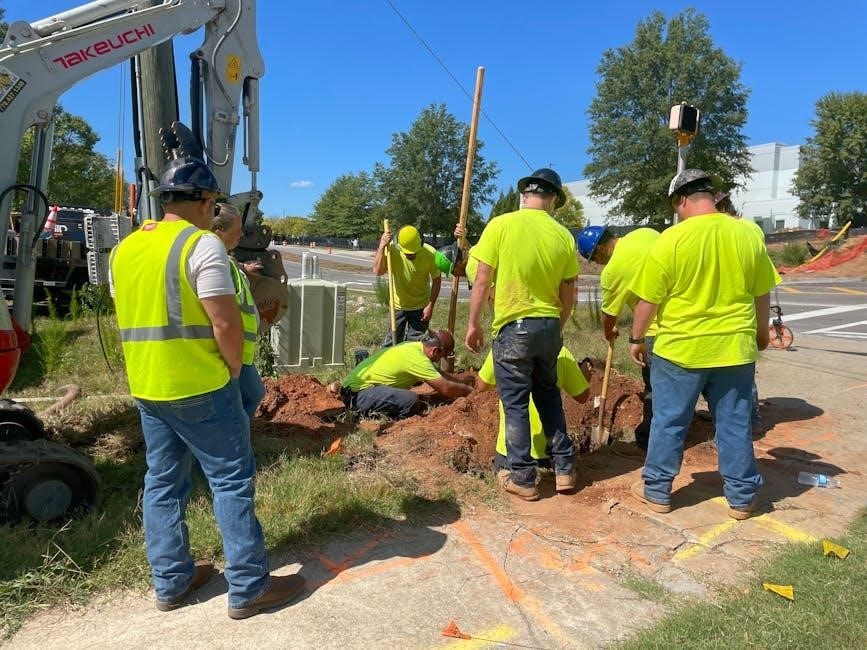Overview of the Singer 4423 Sewing Machine
The Singer 4423 is a heavy-duty sewing machine designed for durability and versatility‚ ideal for sewing heavy fabrics like denim and canvas. It features a robust metal frame‚ powerful motor‚ and advanced stitching capabilities‚ making it suitable for both home use and small-scale professional projects. The machine comes with a comprehensive instruction manual that guides users through setup‚ operation‚ and maintenance‚ ensuring optimal performance and longevity. Its ease of use and reliability make it a popular choice among sewists of all skill levels.
1.1 Model Specifications
The Singer 4423 Heavy Duty Sewing Machine features a robust metal frame and powerful motor‚ capable of sewing up to 1‚100 stitches per minute. It includes 23 built-in stitches‚ a one-step buttonhole‚ and a variety of presser feet for versatile sewing tasks. Designed for heavy-duty use‚ it handles thick fabrics like denim and canvas with ease; The machine weighs approximately 14.5 pounds‚ making it portable yet sturdy. Its dimensions are compact‚ fitting well in home sewing spaces. The Singer 4423 is compatible with a range of accessories‚ including zipper‚ buttonhole‚ and blind hem feet‚ enhancing its functionality for both beginners and experienced sewists.
1.2 Target Audience
The Singer 4423 Heavy Duty Sewing Machine is designed for sewists of all skill levels‚ from beginners to experienced crafters. Its versatility makes it ideal for home sewers‚ hobbyists‚ and small-scale professionals. The machine is particularly suited for those who work with heavy fabrics like denim‚ canvas‚ and leather. Its durability and ease of use also appeal to DIY enthusiasts and seamstresses who prioritize reliability and performance. Whether for repairs‚ upholstery‚ or creating custom projects‚ the Singer 4423 caters to a wide range of sewing needs‚ making it a practical choice for anyone seeking a robust and user-friendly sewing machine.
1.3 Key Features
The Singer 4423 Heavy Duty Sewing Machine boasts a robust metal frame‚ ensuring durability and stability during operation. It features a powerful motor capable of sewing through thick fabrics with ease. The machine includes 23 built-in stitches‚ offering versatility for various sewing projects. Additional features like a free-arm design and drop feed allow for easier handling of complex tasks such as quilting and embroidery. Its heavy-duty construction and user-friendly interface make it suitable for both home and professional use. The machine also comes with a comprehensive instruction manual‚ guiding users through its features and maintenance‚ ensuring optimal performance and longevity.

Setting Up the Singer 4423 Sewing Machine
Setting up the Singer 4423 involves unpacking‚ inspecting parts‚ and following safety guidelines. The instruction manual provides detailed steps for assembly and initial configuration‚ ensuring smooth operation.
2.1 Unpacking and Initial Inspection
Carefully unpack the Singer 4423 sewing machine and inspect for any damage. Ensure all accessories‚ like the power cord‚ bobbin‚ and presser feet‚ are included. Check the machine’s exterior for scratches or dents. Verify that the stitch selector‚ tension dials‚ and other controls are intact. Before plugging in‚ ensure the power cord is undamaged. Familiarize yourself with the machine’s parts using the manual’s diagrams. If any components are missing or damaged‚ contact Singer support immediately. Proper inspection ensures safe and efficient operation. Always follow the manual’s guidelines for setup and use.
2.2 Understanding the Machine Parts
Familiarize yourself with the Singer 4423’s components to ensure proper operation. Key parts include the stitch selector‚ tension dials‚ bobbin case‚ and presser feet. The stitch selector allows you to choose from various stitch patterns‚ while the tension dials control thread tightness. The bobbin case holds the lower thread‚ and presser feet guide fabric movement. Locate the power switch‚ handwheel‚ and reverse stitch lever for basic controls. Refer to the manual’s diagrams for detailed descriptions of each part. Understanding these components helps you operate the machine effectively and troubleshoot issues. Always use the manual as a reference for identifying and using each part correctly.
2.3 Safety Guidelines
To ensure safe operation‚ read and follow all safety guidelines in the Singer 4423 instruction manual. Always use genuine Singer parts and accessories to maintain machine performance. Avoid wearing loose clothing or jewelry that could get caught in moving parts. Keep children and pets away while sewing. Never insert objects into openings or touch hot surfaces. Ensure the machine is placed on a stable‚ flat surface. Disconnect the power cord when not in use or during maintenance. Follow all warnings and precautions outlined in the manual to prevent accidents and ensure optimal performance. Regularly inspect the machine for damage. Refer to the manual for detailed safety information.
Reading the Singer 4423 Instruction Manual
Reading the Singer 4423 instruction manual is essential for understanding machine operations‚ safety guidelines‚ and troubleshooting. It provides detailed explanations of features‚ parts‚ and maintenance. Available for free download in PDF format‚ the manual ensures users can access critical information anytime. By following the manual‚ sewists can optimize performance‚ prevent errors‚ and extend the machine’s lifespan. Regular updates and online resources further enhance the user experience‚ making it a vital resource for both beginners and experienced sewists.
3.1 Importance of the Instruction Manual
The Singer 4423 instruction manual is crucial for maximizing machine performance and ensuring safety. It provides detailed guidance on setup‚ operation‚ and maintenance‚ helping users avoid common mistakes. The manual includes troubleshooting tips and parts lists‚ enabling quick resolution of issues. By following the manual‚ users can extend the machine’s lifespan and maintain its efficiency. Available in PDF format‚ it offers convenience for reference anytime. Adhering to the manual’s guidelines ensures optimal sewing results and prevents potential damage to the machine. Regularly reviewing the manual helps users stay informed about best practices and safety precautions. It is an indispensable resource for all users.
3.2 Navigating the Manual
The Singer 4423 instruction manual is organized to help users easily find information. It begins with a table of contents and an index‚ allowing quick access to specific topics. The manual is divided into clear sections‚ such as setup‚ operation‚ and troubleshooting‚ with detailed diagrams and illustrations. Each section is numbered for easy navigation‚ and key terms are highlighted for quick reference. Users can locate parts lists‚ safety guidelines‚ and stitch charts effortlessly. The logical flow ensures that even complex tasks‚ like threading or bobbin winding‚ are explained step-by-step. This structure makes the manual user-friendly and accessible for sewists of all skill levels.
3.3 Symbols and Terminology
The Singer 4423 manual uses specific symbols and terminology to guide users effectively. Symbols like warning signs indicate safety precautions‚ while diagram keys explain parts and functions. Terms such as bobbin‚ presser foot‚ and stitch width are defined to ensure clarity. The manual also includes a glossary of sewing-related terms‚ helping users understand technical language. By standardizing these symbols and terms‚ the manual ensures consistency and ease of understanding. This section is crucial for new users to decode instructions and operate the machine confidently; Proper familiarity with these elements enhances safety and efficiency while sewing.

Basic Operations
The Singer 4423 manual details essential steps for threading‚ bobbin winding‚ and stitch selection‚ ensuring smooth operation. These processes are fundamental for beginners and experienced users alike.
4.1 Threading the Machine
Threading the Singer 4423 is a straightforward process outlined in the manual. Begin by turning the handwheel to raise the take-up lever. Place the thread through the upper tension disc‚ then guide it through the channel and take-up lever. Next‚ thread the needle from front to back. Ensure the thread is seated properly in the tension spring. Finally‚ pull the thread gently to test the tension. Proper threading is essential for even stitching and prevents thread breakage during sewing. Always refer to the manual for visual guides to avoid common mistakes.
4.2 Winding the Bobbin
Winding the bobbin for the Singer 4423 is a simple process. Start by placing the thread on the spool pin and guide it through the bobbin winder. Engage the bobbin winder mechanism and gently start the machine to wind the thread evenly. Stop when the bobbin is full‚ then cut the excess thread. Ensure the bobbin is properly seated in the bobbin case before use. Always use the correct type of bobbin (Class 15) for the Singer 4423. Proper winding ensures smooth stitching and prevents thread tangles. Refer to the manual for visual guides to avoid common mistakes during this process.
4.3 Selecting Stitches
The Singer 4423 offers a variety of stitches‚ including straight‚ zigzag‚ and decorative options‚ to suit different sewing projects. To select a stitch‚ turn the stitch dial to the desired pattern or use the stitch selector button. Refer to the stitch chart on the machine or in the manual for guidance. Always match the stitch type to the fabric and project needs. Use the backstitch feature at the start and end of seams for secure stitching. Proper stitch selection enhances the quality and durability of your work. This feature-rich system makes the Singer 4423 versatile for both basic and advanced sewing tasks.

Advanced Features of the Singer 4423
The Singer 4423 features a variety of stitch options‚ including straight‚ zigzag‚ and decorative stitches. To select a stitch‚ simply turn the stitch dial or press the stitch selector button. Always refer to the stitch chart on the machine or in the manual for guidance. Choose the appropriate stitch based on fabric type and project requirements. Use the backstitch feature at the start and end of seams for added security. Proper stitch selection ensures professional-looking results and enhances the durability of your work. This feature makes the Singer 4423 ideal for both basic and advanced sewing tasks.
5.1 Heavy-Duty Sewing Capabilities
The Singer 4423 excels in heavy-duty sewing‚ featuring a robust metal frame and powerful motor designed to handle thick fabrics like denim‚ canvas‚ and leather. With a maximum stitch speed of 1‚100 stitches per minute‚ it efficiently sews through multiple layers of heavy materials. The machine is equipped with a heavy-duty stitching system‚ ensuring strong and durable seams. Its advanced gear system provides consistent power‚ making it ideal for demanding projects. Always use the appropriate heavy-duty needles and presser feet as recommended in the manual to maintain performance and prevent damage. This capability makes the Singer 4423 a reliable choice for professionals and home users alike.
5.2 Free-Arm Sewing
The Singer 4423 offers free-arm sewing‚ enabling easy stitching of cylindrical or hard-to-reach areas like sleeves‚ pant legs‚ and small crafts. By detaching the flatbed‚ users gain access to the free arm‚ providing a large‚ unobstructed workspace. This feature is particularly useful for precision sewing‚ allowing better control over fabric movement; The machine’s free-arm design is ideal for sewing delicate or curved projects‚ such as collars‚ cuffs‚ and children’s clothing. Refer to the instruction manual for guidance on how to engage free-arm mode and optimize your sewing experience for various fabric types and creative projects. This versatility enhances both convenience and creativity.
5.3 Using the Built-In Stitches
The Singer 4423 comes with a variety of built-in stitches‚ including straight‚ zigzag‚ and decorative options‚ designed to cater to diverse sewing needs. Users can easily select stitches using the machine’s dial or button controls‚ as detailed in the instruction manual. These stitches are ideal for sewing heavy fabrics‚ reinforcing seams‚ and adding decorative elements to projects. The machine’s heavy-duty construction ensures consistent stitch quality‚ even on thick materials. By following the manual’s guidance‚ users can maximize the potential of these stitches to achieve professional-grade results in both practical and creative sewing tasks. This feature enhances versatility and creativity for sewists of all levels.

Maintenance and Care
Regular maintenance ensures the Singer 4423’s optimal performance. Clean the machine‚ oil moving parts‚ and inspect for wear and tear to extend its lifespan and reliability.
6.1 Cleaning the Machine
Regular cleaning is essential to maintain the Singer 4423’s performance. Turn off and unplug the machine before cleaning. Use a soft brush to remove lint and debris from the bobbin area‚ tension discs‚ and under the stitch plate. Dampen a cloth with water or sewing machine oil to wipe down exterior surfaces‚ avoiding harsh chemicals. Pay special attention to areas around the needle and feed dogs‚ where dust and thread fragments often accumulate. Cleaning ensures smooth operation and prevents damage from built-up residue. Refer to the manual for detailed cleaning instructions and recommendations.
6.2 Oiling the Machine
Regular oiling is crucial for the Singer 4423’s smooth operation and longevity. Use only Singer-recommended sewing machine oil to lubricate internal components. Locate the oiling points as indicated in the manual‚ typically near the bobbin area and hook race. Apply a few drops of oil periodically‚ ensuring not to over-lubricate‚ as excess oil can attract dust and cause issues. Turn the handwheel gently to distribute the oil evenly. Oiling prevents friction‚ reduces wear‚ and maintains stitch quality. Refer to the manual for specific oiling intervals and instructions to keep your machine running efficiently and reliably over time.
6.3 Checking for Wear and Tear
Regularly inspect the Singer 4423 for wear and tear to ensure optimal performance. Check the bobbin area‚ feed dogs‚ and tension discs for signs of damage or debris. Examine the needle‚ presser foot‚ and belts for excessive wear. Lubricate moving parts as needed and replace worn components promptly. Clean the machine thoroughly to prevent dust buildup‚ which can cause mechanical issues. Refer to the manual for specific inspection points and maintenance schedules. Addressing wear and tear early helps maintain stitch quality and prevents costly repairs‚ ensuring your machine runs smoothly for years. Always use genuine Singer replacement parts for reliability.

Troubleshooting Common Issues
The Singer 4423 instruction manual includes a detailed troubleshooting guide to help identify and resolve common issues‚ ensuring smooth operation and extending the machine’s lifespan effectively.
7.1 Thread Breakage
Thread breakage is a common issue that can occur due to improper threading‚ incorrect tension settings‚ or using low-quality thread. To resolve this‚ ensure the machine is threaded correctly‚ following the manual’s guidelines. Check the tension discs and adjust them as needed to maintain even tension. Using high-quality‚ compatible threads recommended by Singer can also prevent frequent breakage. Regularly cleaning the machine and ensuring the needle is properly inserted can further minimize this issue. Refer to the troubleshooting section of the manual for detailed steps to diagnose and fix thread breakage effectively. Proper maintenance ensures smooth sewing operations.
7.2 Uneven Stitching
Uneven stitching can occur due to incorrect tension settings‚ improper threading‚ or a misaligned needle. To address this‚ check the thread tension and adjust it as per the manual’s instructions. Ensure the needle is properly inserted and aligned. If the issue persists‚ consult the troubleshooting section of the Singer 4423 manual for guidance. Regularly cleaning the machine and using high-quality threads can also help maintain consistent stitching. Always refer to the manual for specific adjustments to achieve smooth‚ even stitching and prevent further complications during your sewing projects. Proper maintenance ensures optimal performance and desired results.
7.3 Bobbin Problems
Bobbin issues‚ such as improper threading or misalignment‚ can disrupt stitching. If the bobbin is not correctly inserted or the thread is tangled‚ uneven stitching or thread breakage may occur. To resolve this‚ ensure the bobbin is properly seated and aligned with the machine’s bobbin case. Regularly clean the bobbin area to remove lint or debris. If the problem persists‚ refer to the Singer 4423 manual’s troubleshooting guide for detailed steps. Using genuine Singer parts and following the manual’s maintenance tips can help prevent future bobbin-related issues and ensure smooth sewing operations. Always follow the manual’s recommendations for optimal performance.

Accessories and Replacement Parts
The Singer 4423 supports various accessories‚ including additional presser feet and needles‚ to enhance sewing capabilities. Genuine Singer parts ensure optimal performance and longevity.
8.1 Compatible Accessories
The Singer 4423 is compatible with a variety of accessories that enhance its functionality. These include heavy-duty needles‚ walking feet‚ and specialized presser feet for tasks like zippers and buttonholes. Additional attachments such as extension tables and storage cases are also available. Using genuine Singer accessories ensures compatibility and optimal performance. The instruction manual provides a detailed list of recommended parts and where to purchase them. Always check for compatibility before buying to maintain your machine’s efficiency and extend its lifespan. Genuine Singer parts are designed to meet high standards‚ ensuring durability and reliability.
8.2 Ordering Replacement Parts
To maintain your Singer 4423 sewing machine’s performance‚ genuine replacement parts are essential. The instruction manual includes a detailed parts list with descriptions and part numbers. Visit Singer’s official website or authorized dealers to order replacement parts. Sewing Parts Online and other trusted retailers also offer compatible components. Always verify the authenticity of parts to ensure compatibility and quality. For convenience‚ Many retailers offer online ordering with shipping directly to your home. When ordering‚ use the part numbers from your manual to avoid errors. Genuine Singer parts ensure optimal performance and extend the machine’s lifespan. Promptly address any issues to maintain functionality.
8.3 Using Genuine Singer Parts
Using genuine Singer parts ensures optimal performance and longevity of your Singer 4423 sewing machine. The instruction manual emphasizes the importance of authentic components for compatibility and reliability. Genuine parts are specifically designed to meet the machine’s specifications‚ guaranteeing smooth operation and preventing potential damage. Non-Singer parts may void the warranty and lead to mechanical issues. Always refer to the parts list in the manual when ordering replacements. For authenticity‚ purchase directly from Singer’s official website or authorized dealers. This ensures your machine continues to deliver the quality and durability you expect. Regularly check for updates or recalls on Singer’s customer support page.

Singer 4423 Instruction Manual Download
The Singer 4423 instruction manual is available for free download in PDF format‚ ensuring easy access to guidance for setup‚ operation‚ and troubleshooting. Users can find it on Singer’s official website or through authorized dealers without registration. The manual is provided in multiple languages‚ including English‚ Russian‚ and Italian‚ catering to a diverse user base. Downloading the manual allows sewists to reference instructions anytime‚ ensuring optimal use of their Singer 4423 sewing machine. This convenience enhances the overall sewing experience.
9.1 Finding the Manual Online
Locating the Singer 4423 instruction manual online is straightforward. Visit Singer’s official website or authorized dealers to access the PDF file for free. Sewing communities and forums also provide direct links to download the manual without registration. Ensure you use trusted sources to avoid outdated or incorrect versions. The manual is available in multiple languages‚ including English‚ Russian‚ and Italian‚ to cater to a global audience. Additionally‚ it can be downloaded in formats like PDF or TXT‚ making it easily accessible on various devices. This ensures users can reference the guide anytime‚ enhancing their sewing experience.
9.2 Downloading in PDF Format
Downloading the Singer 4423 instruction manual in PDF format is a quick and convenient process. The PDF file is available on Singer’s official website‚ authorized dealer pages‚ and trusted sewing forums. Ensure you download from verified sources to guarantee authenticity and safety. The PDF format allows for easy navigation‚ including bookmarks and search functionality‚ making it simple to locate specific sections. With a file size of approximately 1.04 MB‚ it downloads swiftly‚ even on slower connections. The PDF manual is compatible with all major devices‚ ensuring accessibility anytime‚ anywhere. This format preserves the manual’s layout and clarity‚ providing a seamless reading experience.
9.3 Printing the Manual
Printing the Singer 4423 instruction manual from the PDF file is straightforward. Use a standard printer with A4 or letter-sized paper for optimal results. Ensure the printer settings are configured for high-quality text and images to maintain clarity. For better readability‚ print in color if possible‚ as the manual includes diagrams and illustrations. Consider printing only the sections you need‚ such as troubleshooting or maintenance‚ to save paper. If desired‚ bind the pages for a professional finish. Singer’s customer support also offers physical copies upon request‚ ensuring you have a hardcopy for easy reference. This makes the manual accessible offline and convenient for everyday use.

Singer Customer Support
Singer offers comprehensive customer support‚ including phone‚ email‚ and live chat services. Their website provides FAQs‚ video tutorials‚ and downloadable resources to assist with any queries or issues.
10.1 Contacting Singer Support
To contact Singer support‚ visit their official website and navigate to the “Support” section. Here‚ you can find contact details‚ including phone numbers‚ email addresses‚ and live chat options. The support team is available to assist with troubleshooting‚ warranty claims‚ and general inquiries. Additionally‚ Singer provides a comprehensive FAQ section and downloadable resources like manuals and guides. For urgent issues‚ calling their customer service hotline is recommended. Ensure to have your machine model number‚ such as Singer 4423‚ ready for efficient assistance. This streamlined process ensures quick resolution to any queries or concerns. Singer’s dedicated support team is committed to helping you maximize your sewing experience.
10.2 Warranty Information
The Singer 4423 sewing machine is backed by a 25-year limited warranty on parts and labor‚ with 2 years on electrical components and 1 year on belts. To activate the warranty‚ register your machine online within 30 days of purchase. The warranty covers defects in materials and workmanship under normal use. However‚ it does not apply to damage caused by misuse‚ neglect‚ or improper maintenance. For warranty claims‚ contact Singer support with your proof of purchase and machine serial number. Regular maintenance‚ as outlined in the instruction manual‚ ensures warranty validity and optimal performance. Singer’s warranty provides peace of mind for your sewing investment.
10.3 Online Resources
Singer offers extensive online resources to support the 4423 sewing machine. Users can download the PDF instruction manual directly from Singer’s official website. Additionally‚ Singer provides tutorial videos‚ FAQs‚ and troubleshooting guides to address common issues. The Singer website also features a dedicated section for software updates and stitch guides. For further assistance‚ Singer’s customer support is accessible via live chat‚ email‚ or phone. These resources ensure that users can fully utilize their machine’s features and resolve any challenges efficiently. Singer’s online platform is a comprehensive hub for all user needs‚ enhancing the sewing experience.

Community and User Resources
The Singer 4423 sewing machine is supported by an active community of users who share tips‚ projects‚ and troubleshooting advice online. Sewing forums‚ social media groups‚ and YouTube channels offer tutorials and reviews‚ enhancing the sewing experience for both beginners and experts. These resources complement the official manual‚ providing real-world insights and creative inspiration for maximizing the machine’s capabilities.
11.1 Sewing Communities
Sewing communities provide invaluable support and inspiration for Singer 4423 users. Online forums‚ Facebook groups‚ and Reddit threads dedicated to sewing machines offer platforms for sharing tips‚ projects‚ and troubleshooting advice. These communities are rich with user-generated content‚ including tutorials and creative ideas tailored to the Singer 4423. Members often discuss their experiences‚ providing real-world insights and solutions to common challenges. Whether you’re a beginner or an advanced sewer‚ these communities foster learning and collaboration‚ helping you make the most of your machine. They complement the official manual by offering practical‚ community-driven guidance and inspiration for your sewing journey.
11.2 User Reviews
User reviews of the Singer 4423 highlight its durability and versatility‚ with many praising its ability to handle heavy fabrics effortlessly. Sewists appreciate the machine’s robust construction and smooth operation‚ making it ideal for both casual and intensive projects. Positive feedback often mentions the ease of use‚ even for beginners‚ and the wide range of built-in stitches. Some users note that the machine’s weight adds stability‚ reducing vibrations during use. While a few mention a steeper learning curve for advanced features‚ overall satisfaction is high‚ with many recommending it for its reliability and value. Reviews also emphasize the importance of following the manual for optimal performance.
11.3 Tutorials and Videos
Tutorials and videos for the Singer 4423 provide visual guidance‚ complementing the instruction manual. Official Singer channels and third-party creators offer step-by-step demonstrations‚ covering basic operations‚ advanced features‚ and troubleshooting. These resources are particularly helpful for users who prefer hands-on learning or need clarification on specific functions. Videos often include tips for optimizing stitch quality‚ maintaining the machine‚ and resolving common issues. Many tutorials are designed for sewists of all skill levels‚ making the Singer 4423 more accessible. They serve as a valuable supplement to the manual‚ offering real-time problem-solving and enhancing the overall sewing experience.























































